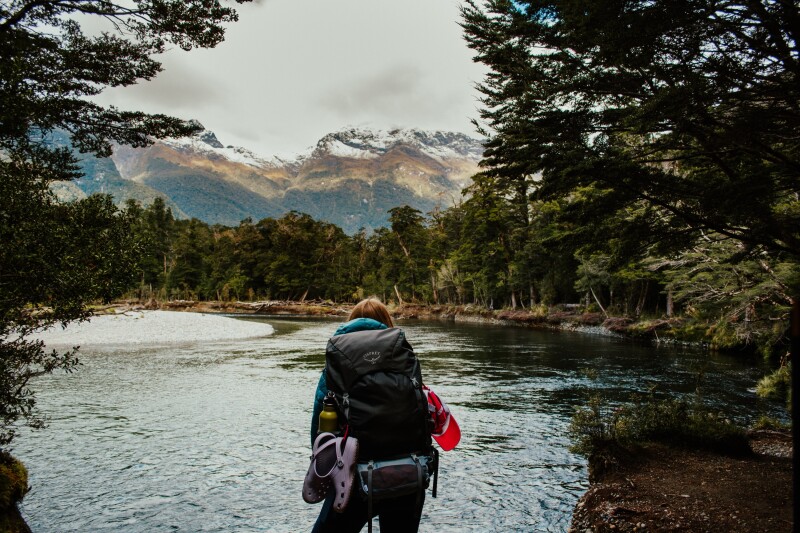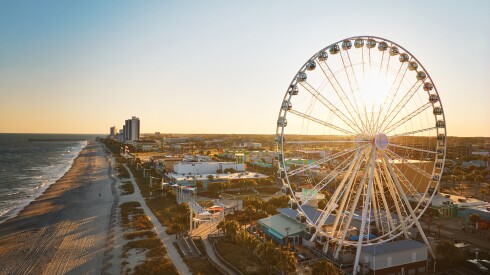True solitude is the ultimate luxury in an era where travel often feels overcrowded and overdone. Remote escapes—consisting of unspoiled landscapes, unique wildlife, and immersive experiences—are topping travel wish lists in 2025.
After recent developments such as improved infrastructure and eco-conscious lodging, these 11 crowd-free getaways promise discovery and serenity. Here’s how to experience them—and where to stay—while embracing the joy of isolation.

Around 70 years ago, David Attenborough came to Guyana to film a series about exotic animals.
Photo by David Di Gregorio
Guyana
New direct flights from New York and Miami and rapid development in the country’s capital, Georgetown, are making this remote South American country more accessible. Guyana is one of Afar’s top destinations for 2025. Among its dramatic landscapes is the 741-foot Kaieteur Falls, the world’s largest single-drop waterfall—four times taller than Niagara Falls. The Rupununi Savannah in the country’s south is another ecological wonder, with jaguars, giant anteaters, and 10-foot-wide lily pads.
Book a tour with Wilderness Explorers, Guyana’s oldest tour operator, to navigate the country’s less-developed interior and connect with Indigenous communities.
Where to stay: Caiman House Ecolodge
- Book now: caimanhouse.com
Caiman House Ecolodge is in the heart of Yupukari Village in the Rupununi Savannah. This Indigenous-run, four-bedroom lodge offers nighttime excursions to track black caimans, the largest alligator species. Plus, its revenue surplus goes to local projects, such as the village public library.

The icy Greenland is located between the Arctic and Atlantic oceans.
Photo by Carsten Snejbjerg
Greenland
Greenland is experiencing a travel renaissance. With the expansion of Nuuk Airport (GOH) and direct flights launching from Newark (United Airlines) and Copenhagen (Scandinavian Airlines) in 2025, the world’s largest island is more accessible than ever. Yet Greenland remains untamed: Sailing through the Ilulissat Icefjord, a UNESCO World Heritage site, you’ll encounter massive icebergs hundreds of feet above sea level.
In winter, the northern lights paint the night sky with an ethereal glow, while summer brings more than 20 hours of daylight for exploring glaciers and fjords.
Where to stay: Hotel Arctic
- Book now: hotelarctic.com
Hotel Arctic in Ilulissat offers eco-conscious luxury above the famed Icefjord. Igloo-shaped cabins provide unmatched views of drifting icebergs, while the restaurant serves Arctic ingredients like Greenlandic lamb and halibut.

Baobab trees are among the distinctive sights in Madagascar.
Photo by Framalicious/Shutterstock
Madagascar
Madagascar is a natural wonderland that includes the razor-sharp limestone formations of Tsingy de Namoroka National Park and endemic fauna all around. Much is unique to the island: 98 percent of Madagascar’s land mammals, 92 percent of its reptiles, and 41 percent of its bird species exist nowhere else on the planet. New tour offerings are making this destination a place to experience this year. Consider a small group experience from Abercrombie & Kent that explores the island’s famed baobab trees and lemurs.
Where to stay: Namoroka Tsingy Safari Camp
- Book now: madaclassic.com/namoroka-home
The fully solar-powered Namoroka Tsingy Safari Camp, which opened in August 2024, is the exclusive accommodation option within Namoroka National Park.

After a day exploring Kerlingarfjöll, cozy up in front of a large picture window in the lounge with a hot chocolate and a book.
Courtesy of Highland Base Kerlingarfjöll
Kerlingarfjöll, Iceland
From the Westfjords region in the northwest to the F-roads that lead to mountainous areas in the country, Iceland has its fair share of remote places. One of its most exciting is the Kerlingarfjöll in the country’s interior. The geothermal area is far from the crowded Golden Circle and offers hikers the chance to experience surreal volcanic landscapes and soak in secluded geothermal pools. Winter visitors might catch the northern lights, while summer unveils a colorful terrain under the midnight sun.
Just make sure you pack for every weather scenario. The Icelandic highlands are unpredictable, and layering is key.
Where to stay: Highland Base Kerlingarfjöll
- Book now: highlandbase.is
Kerlingarfjöll is more accessible than ever with the opening of this hotel, named one of Afar’s best stays of 2024. The resort combines sleek Nordic design with proximity to geothermal trails, an ideal base for exploring Iceland’s highlands.

Polar bears outnumber people in the Svalbard Islands.
Photo by Wildnerdpix/Shutterstock
Svalbard
Svalbard, located halfway between Norway and the North Pole, has more polar bears than people. This archipelago has become popular as a cruise ship destination for companies including Seabourn, Hurtigruten, and HX, but the location still feels like the edge of the Earth. That is, in part, thanks to new regulations that limit the size of cruise ships coming through.
The tiny town of Longyearbyen is where many travelers base their travels in the region, with boutique stays—like the 2018-opened Svalbard Hotel the Vault and the 2017-renovated Funken Lodge—and expert guides ready to help you safely navigate the wilderness.
Where to stay: Funken Lodge
- Book now: funkenlodge.com
Funken Lodge in Longyearbyen blends Nordic elegance with cozy charm. After days spent exploring glaciers and spotting polar wildlife, enjoy Arctic-inspired dishes made with local ingredients and paired with panoramic views of the tundra.

Enjoy stargazing with Good Heavens, a dark sky experience company.
Photo by Carmen Bird
Aotea (Great Barrier Island), New Zealand
Also on Afar’s Where to Go in 2025 list, Aotea (Great Barrier Island) is an off-the-grid paradise of white-sand beaches and old-growth kauri forests. The island is 60 miles northeast of Auckland, and most of it is a wildlife reserve, home to rare species like the pāteke, one of the world’s rarest ducks. Named an International Dark Sky Sanctuary in 2017, Aotea is a prime stargazing destination. The island also offers a front-row seat to the southern lights and countless constellations.
Where to stay: 175° East
- Book now: 175east.nz
This accommodation features three luxurious hilltop homes with panoramic sea views and sustainable design. Located near Medlands Beach, it’s an ideal retreat for connecting with nature and the stars.

Many Antarctica cruises depart from Ushuaia, Argentina.
Courtesy of Caroline Cagnin/Pexels
Ushuaia, Argentina
Ushuaia, the southernmost city on Earth, is a gateway to the untamed glacial landscapes of Tierra del Fuego and Antarctica. Take a boat trip through glacier-carved fjords, hike forested trails in Tierra del Fuego National Park, or ride the historic Train to the End of the World.
This part of South America has seen a rise in interest because of properties like Gran Meliá (scheduled to open in 2028) and the planned Silversea hotel, a two-hour ferry away in Puerto Williams, Chile (scheduled to open by the end of 2025). Soon, it’ll be much easier to explore this wilderness without sacrificing comfort. Tip: The best time to visit is from November to March, during the summer in the Southern Hemisphere, when trails are accessible and wildlife is active.
Where to stay: Arakur Ushuaia Resort & Spa
- Book now: arakur.com
Arakur Ushuaia Resort & Spa, perched on a nature reserve, offers panoramic views of the Beagle Channel and Andes. The property also offers guided hikes and heated pools.

This year, explore Pakistan’s mountainous terrain.
Photo by Punnawit Suwattananun/Shutterstock
Nangma Valley, Pakistan
Despite boasting three of the world’s great mountain ranges—the Himalayas, Karakoram, and the Hindu Kush—and peaks like K2, Pakistan has historically attracted fewer than 20,000 adventure travelers annually. This is changing, with a 115 percent rise in foreign visitors in 2023.
Travelers heading to this part of northeastern Pakistan can experience new itineraries like Intrepid Travel’s Trek Pakistan’s Karakoram Mountains, launched in the summer of 2024. Often dubbed the “Yosemite of Pakistan,” this region is a mountaineer’s dream, with dramatic granite spires, treks through glacial streams, and emerald meadows.
Where to stay: Intrepid
- Book now: intrepidtravel.com
It’s easiest to snag accommodations in the remote Nangma Valley through outfitters like Intrepid. The company’s 10-day Karakoram Mountains itinerary begins in Islamabad and takes travelers through the Hunza Valley before reaching Nangma’s soaring peaks. The experience features expert guides, porters, and a dedicated cooking team, so you can focus on soaking in the spectacular surroundings without worrying about logistics.

South Luangwa National Park is home to plenty of safari animals like giraffes.
Photo by Otto Borik/Shutterstock
Zambia
Zambia is quickly emerging as one of Africa’s premier safari destinations. Its South Luangwa National Park, home to leopards, lions, and elephants, is renowned for walking safaris, which allow visitors to connect with the land without the crowds. In 2024, Few & Far launched a sustainable Zambia-Zimbabwe safari itinerary, and the iconic Chichele Presidential Lodge is undergoing a stunning redesign.
Where to stay: Chichele Presidential Lodge
- Book now: chiawa.com/chichele-presidential
Set on a hill in South Luangwa National Park, Chichele Presidential Lodge was originally constructed for a former Zambian president during the 1970s as his personal holiday home. The property is set to fully reopen in 2025, with panoramic views of the valley below.

Located in Fiordland National Park, Milford Track goes through mountains and temperate rainforest.
Courtesy of Claire Kelly/Unsplash
Milford Track, New Zealand
One of the most scenic walks in New Zealand, the Milford Track covers about 30 miles and leads into Milford Sound, known for its dramatic coastal views. A nearly four-hour drive from the nearest city of Queenstown, the Milford Track is categorized as one of New Zealand’s “Great Walks,” prompting many people to hike the five-day circuit, which takes hikers past rainforests, waterfalls, misty mountains, and glaciers.
Warning: This trek should only be attempted by serious hikers who are comfortable carrying what they need with them. There’s also no cellphone coverage over most of Milford Track.
Where to stay: Ultimate Hikes
- Book now: ultimatehikes.co.nz
Ultimate Hikes is the exclusive operator of multi-day guided walks on the Milford Track. Its private lodges include shared and private rooms, washing and drying rooms for hiking gear, and generated electricity until 10 p.m.

This remote place is the last British Territory in the South Pacific.
Courtesy of Wendi Halet/Flickr
The Pitcairn Islands
It’s safe to say that Pitcairn has an infamous reputation. It’s where the mutineers of the HMS Bounty (of Mutiny on the Bounty fame) settled. To reach Pitcairn, travelers must board a quarterly shipping vessel from Mangareva in French Polynesia for a trip that can take between 4 and 11 days.
Astronomy lovers will find themselves in terrestrial heaven in Pitcairn. The island’s dark skies offer some of the best views of the cosmos. They’re so stellar that Pitcairn was officially designated a Dark Sky Sanctuary in 2018, one of only a few dozen in the world.
Where to stay: Little Flower
There are only a few registered accommodation options on the Pitcairn Islands, spanning homestay and private rentals. Little Flower is one of them, as a studio unit with a private deck overlooking Isaac’s Valley.
This article was originally published in 2023 and most recently updated on February 5, 2025, with current information. Sara Button and Erika Owen contributed to the reporting of this story.











